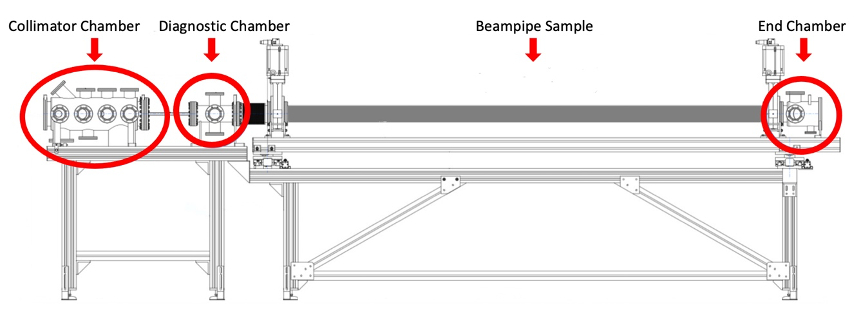In 2017, a Memorandum of Understanding (MoU) between CERN and INFN-LNF (addendum n. 4 MoU INFN / CERN n. KN3083) has been signed. The general purpose of the project is to study the effects of the interactions between synchrotron radiation and technical surfaces. In circular accelerators like LHC or FCC-hh and in all Synchrotron Radiation Facilities, the accelerated particles emit a high number of photons interacting with the wall of the vacuum beam-pipe. These interactions produce different detrimental effects: gas desorption, secondary electron emission, heat load on cold surfaces, etc. that may contribute to the instabilities and affect beam lifetime and the overall accelerator performances. These effects are directly connected to material properties such as Photon Yield (PY), Reflectivity and Photon Stimulated Desorption (PSD). The aim of the project is to extract quantitative information about reflectivity, photon yield and photo induced desorption on representative samples using the Synchrotron Radiation White Light (WL) at DAΦNE.
Such parameters must be studied not only on realistic “technical materials”, but also in conditions as close as possible to the operative ones and this implies that a significant effort is needed to go, whenever possible, at very grazing angle of incidence (as low as 0.08°) and at very low operating temperatures (from 10 to 70 K).
An ideal setup, where all required information can be simultaneously obtained on the same surface, is not yet available and the agreed strategy was to divide the research in two branch lines: the first studying small samples at cryogenic temperatures (down to 10 K) but not at grazing incidence angles (only above 30°); the second to study long beampipes (up to three meters-long) at grazing incidence (down to less than 1°) and at room or Liquid Nitrogen Temperature (LNT).
Studying small samples (~ (8 x 8) mm2) gives the possibility to analyse the temperature effects on the parameters of interest and it also allows to correlate them with other important properties determining accelerator’s performances like the surface chemical state using X ray Photoelectron Spectroscopy (XPS), Secondary Electron Yield (SEY), Electron Stimulated Desorption (ESD), Temperature Programmed Desorption (TPD) that are all available techniques in the laboratory.
In order to study long beampipes, the agreement foresaw the construction of a dedicated white light beamline, realized as branch line of the XUV HEB beamline and, in 2017, the realization of this beamline WINDY (White lIght liNe for Desorption Yields) started. The WINDY setup, shown in fig. 1, is divided into four different parts:
1) the chamber for collimating and analysing the incoming beam.
2) the diagnostic chamber for the analysis of the photo induced desorption.
3) the beampipe sample to be studied.
4) the end station for stopping and analysing the reflected beam.
Between the diagnostic chamber and the end station, the beampipe section can host samples with a maximum length of 3 meter. The WINDY beamline is ready waiting for some stable beam conditions to start the commissioning and to perform the first experiments using synchrotron radiation.

